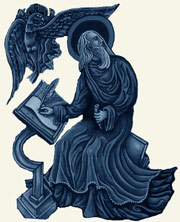through the
rediscovered Akkadian and Ugaritic literatures'![]() ,
and in independent apocalyptic traditions from Persia of the same time.
,
and in independent apocalyptic traditions from Persia of the same time.
Even though a great part of the existing apocalypses were written before 200
CE, the literary tradition remained popular throughout the entire middle ages.
The genre derives its name from the first word of the Apocalypse of John, or Book of Revelation, the Greek 'Apokalypsis' which means revelation. The use of the word as genre label became common from about the 2nd century onward.

Apocalypses are revelatory texts, usually embedded in a dream or vision, in which a divine being (usually an angel) mediates or explains a chronologically or spatially transcendent reality. They mostly disclose an eschatological scenario that focuses on the judgement of the dead and the kingdom of God that is to come. The language applied is generally cryptic. Animal imagery, number symbolism and other worldly journeys are common instruments.
With the
exception of the Apocalypse of John, and the Synoptic
Apocalypses the existing Jewish and Christian apocalypses are
pseudonymous. They used the names of famous ancient men, such as Enoch,
Daniel or Peter and thus were 'prophecies after the fact', or 'vaticina
ex eventu'![]() .
This gave them credibility through authority.
.
This gave them credibility through authority.
Apocalypses were written in times of crises, to give hope to the distressed and motivate them to hold on. A time would come when their enemies would be destroyed by godly intervention and they would be rewarded for their faithfulness.